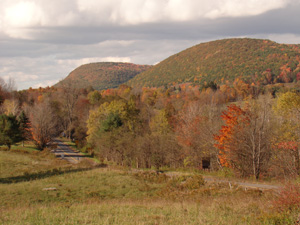New Acquisition Connects Two Plantations Natural Areas
Cornell Plantations is pleased to announce the successful protection of a seven-acre addition to the Caroline Pinnacles Natural Area in the Town of Caroline. The addition increases Plantations’ protected lands within the Bald Hill and Caroline Pinnacles Natural Areas to 265 acres, and of equal importance, provides a long sought connection between these two unique preserves.
“Our interest in protecting the Caroline Pinnacles originates from the educational value it possesses and the significance of its unique natural features,” stated Todd Bittner, director of the Cornell Plantations Natural Areas program. “For the past 150 years, naturalists, botanists and Cornell students have explored the steeply sloping hillsides to study the area’s unique environments.” Caroline Pinnacles derives its name from one of the region’s most dramatic examples of a valley slope over-steepened by glaciers, which gouged at the valley-side as they moved back and forth through the White Church Valley over the millennia.
Caroline Pinnacles derives its name from one of the region’s most dramatic examples of a valley slope over-steepened by glaciers, which gouged at the valley-side as they moved back and forth through the White Church Valley over the millennia.
The west-southwest-facing aspect found there promotes harsh, dry growing conditions. Near the pinnacle’s top, rock outcrops are present, and the stature of the oak forests is dwarfed by exposure. The resulting open forests are dominated by chestnut oak (Quercus montana), red oak (Q. rubra), and black oak (Q. velutina).
Many rare or scarce species found here
Of particular significance is the presence of two plant species, hair grass (Deschampsia flexuosa) and lyrate rock-cress (Arabidopsis lyrata), which have their only known occurrence in the Cayuga Lake basin here. At least 18 locally rare or scarce species of vascular plants and vertebrates, including mountain laurel (Kalmia latifolia), pitch pine (Pinus rigida), and coal skink (Eumeces anthracinus), are also found in this unusual dry, warm, rocky habitat. 



